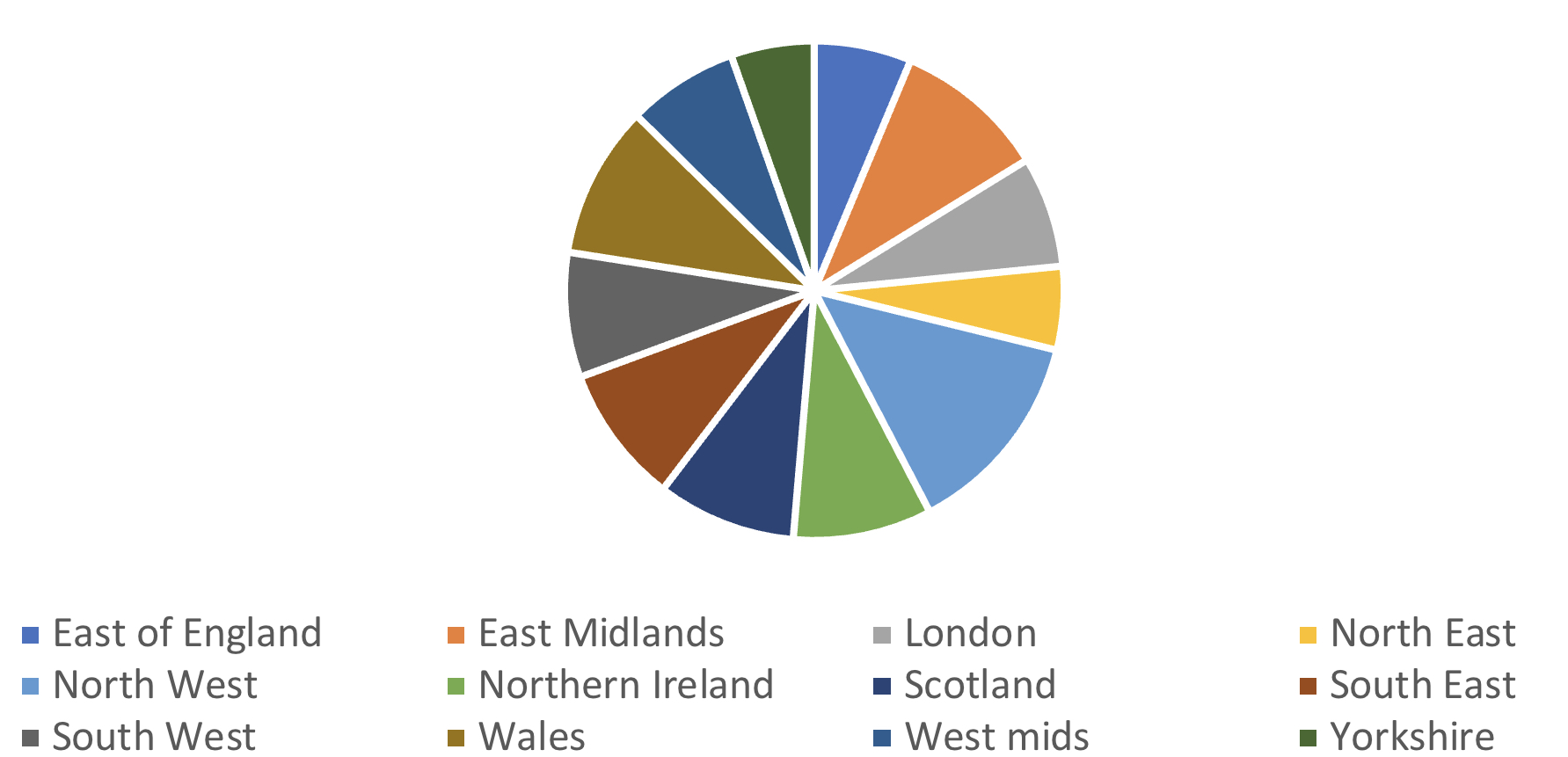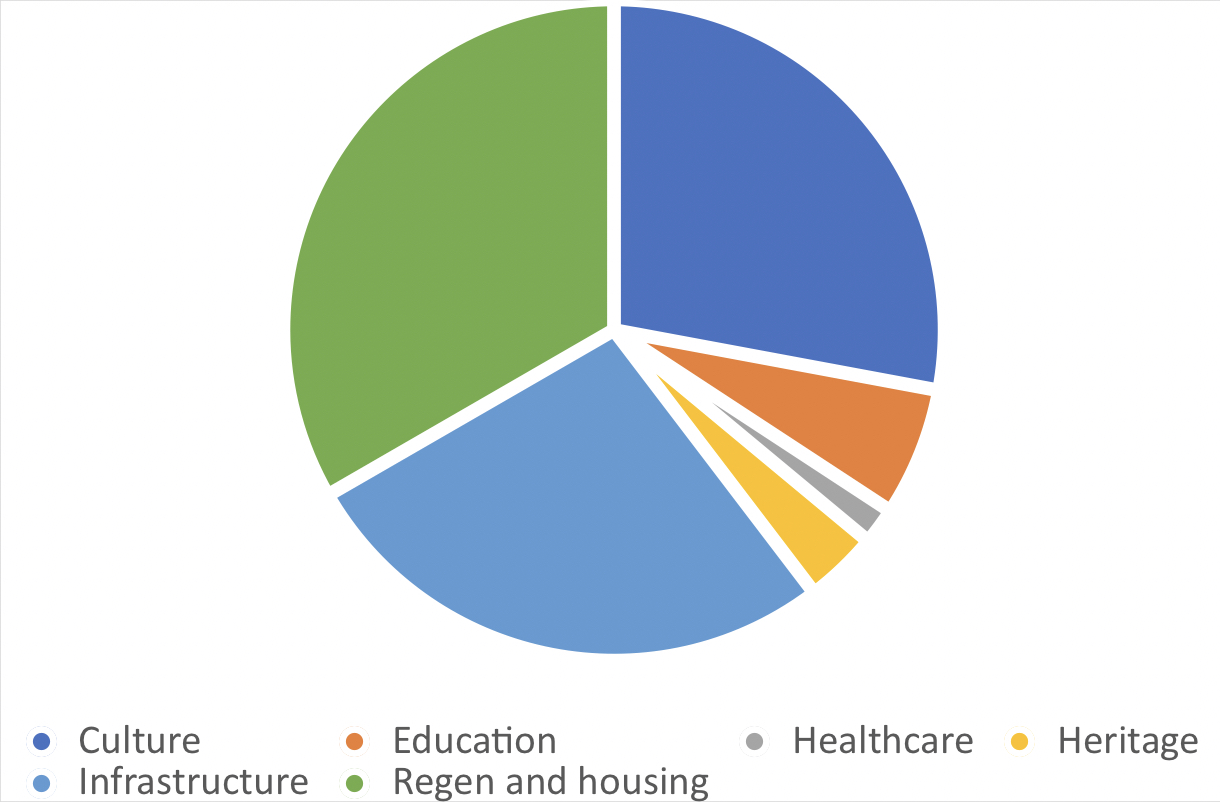Regeneration and CPO Directors, Mark Byles and Alasdair Lowe, consider where the funding is going in the latest round of the Levelling Up agenda.

“The Government has – fairly unfairly – depending on your point of view – come in for some flack over its Levelling Up agenda. The program has been be-devilled by delays, negative press and accusations of muddled thinking. However, the latest round has provided funding – partial or otherwise – for a number of schemes, all of which will benefit their communities.
There has been criticism of government funding ventures that they are still London and South East centric – and while, if grouped together, London and the South East do have the biggest single number of projects benefitting from funding, this chart shows how remarkably even-handed the distribution has been.
Proportion of schemes across UK

Andy Street – the metro Mayor for the West Midlands – has been vocal about the funding not going where it is needed (namely to his area), and he may have some cause for complaint, but it doesn’t appear to be drastic and certainly no more so than in other areas, such as Northern Ireland. This even handedness is visible in the average amount of grant per project as well.
Average per Scheme

While there are differences, the government does seem to have resisted the temptation to try and secure their electoral position and reinforce their Red Wall territory, hard won at the last election. Certainly, the North West is a big part of this, but it hasn’t benefitted any more than Scotland, which is surely a long lost hope, electorally speaking, for the Conservative Party.
While the geographical even-handedness may go someway to alleviating the criticism from some quarters at least, it is also illuminating to look at the type of schemes getting funding. While many schemes have a degree of overlap between their principal category and other sub-categories (quite a few cultural projects with significant highways improvements to improve access to such new projects), there is a pattern emerging.
Somewhat predictably, the lions share of the funding has gone to infrastructure (34%) and regeneration/housing schemes (30%). However, perhaps a surprise front runner in this is cultural projects (24%), which are also seeing a boost in funding.
Distribution of Schemes Approved

On balance, when the average spend on projects is considered as well, it is still infrastructure that has its nose out in front as the government’s priority – which will not surprise many. Though education also fares well, securing high grant allocations for its relatively small number of projects.
Average Spend Per Project Type

While this all seems largely positive, it does come with a caveat. 111 schemes and £2.1 billion are significant numbers, certainly. But in the grand scheme of actually what needs attending to in this country, there is an argument to say this barely scratches the surface. Some 525 projects applied, and as such only every 5th project has succeeded in receiving funding. In addition, the £2.1 billion has to be spent by 25th March 2025, and though that sounds far away, the promoters are going to have to get their skates on, especially if things like Compulsory Purchase Orders are required.
Andy Street’s primary complaint is that civil servants in Whitehall are determining the spending priorities of Solihull. He asks how many of those, admittedly hard working and diligent officers, have even visited the places they are allocating funding to? Is the centralised approach to funding allocations really the best approach to addressing localised projects? Since Covid, there has been an overwhelming shift in priorities from addressing the commuter economy to repositioning local centres, celebrating heritage and re-greening. Grant Shapps says not every decision can be taken by the local mayor, yet really the only decision they can’t make is about funding. With local Councils responsible for the planning and regeneration vision and technical framework for a local area, they are conversely limited from deploying serious funding to actually do anything about implementing that vision, other than relying on negotiated s106 contributions and CIL.
The Levelling Up Fund is very much a double-edged sword. On the one hand it is a great credit to the winning authorities and their funding teams that these schemes have received central government support (after all, there isn’t all the money in the world to go round). But on the other, you cannot remove the political veneer from the allocations and the inherent need for the benefit of said schemes to be seen during the extant government’s term in office. Proper devolution would require trusting Councils that are not politically aligned with the Government to implement projects that, shock horror, may just be for the benefit of their local communities instead of just requiring central government alignment. Sure there will be local political forces at play – there is no sterilised bubble where decisions are made without self-interest. However at least the localisation of the politics will avoid decision-making conflicting with national issues. Trust in the Conservative party however, is in short supply.
There will be a third round, where the last £1 billion in the pot will be distributed – and as such there is hope for those who were not lucky this time – and hopefully the seemingly even distribution of funding will continue to be seen nationwide.”
